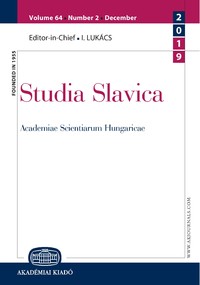Обзор альтернативных типологий славянских языков
An Overview of Alternative Typologies of Slavic Languages
Author(s): Gábor L. BalázsSubject(s): Eastern Slavic Languages
Published by: Akadémiai Kiadó
Keywords: Slavic languages; typology; phonology; morphology; syntax; Baudouin de Courtenay; Haspelmath; fusional languages
Summary/Abstract: The typology of Slavic languages has been frequently dealt with in different publications since the late 19th century. In this paper, the author reviews some of the most significant attempts aimed at the phonological, morphological, and syntactic levels of this typological research. It appears that the phonological classification first elaborated by Baudouin de Courtenay has remained reliable to this day. In morphology, however, the only method for categorization seems to be the identification of certain grammatical markers. Syntactic ty- pology is still a young field of linguistics; nevertheless, there exist promising ventures in it, too. It is remarkable that the typological findings for the modern Slavic languages to a large extent coincide with the results of areal studies. Based on the information presented in the paper, the following implications can be made with reference to the typology of the specific linguistic levels in the Slavic languages. The most uniform level is that of phonological typology because in all the models presented here, a key role is played by two prosodic features: the opposition of long and short vowels, on the one hand, and the character of word stress, on the other. Thus, the pho- nological typology first elaborated by Baudouin de Courtenay has proved to be reliable up to the present. At least no competing theories in this field can be seen for the time being. As to morphological typology, it is not possible to identify features or criteria similar to the phonological models which could be applied for the differentiation of whatever mor- phological types. The Slavic languages, even Bulgarian and Macedonian, which have no nominal declension, have remained fusional (inflectional) languages, within which it is not easy to delineate further subtypes. So far, the only way of morphological categorization seems to be the identification and comparison of individual grammatical features of the different Slavic languages, as it is illustrated tentatively in Section 2. The syntactic typology of the Slavic languages is still a very young field of typologi- cal research. Therefore, it is impossible to arrive at any general conclusions on this matter (besides the ones mentioned in Section 3). The model offered by Haspelmath for the Euro- pean languages looks quite promising but it is necessary to work out further details and spe- cific methods so that it could be successfully applied specifically for the Slavic languages. One cannot fail to notice that the typological regularities specified by way of the mor- phological and syntactic observations in Sections 2 and 3, to a marked extent coincide with the facts of the areal (geographical) classification of the Slavic languages, as it was sharply noticed by Bogoroditsky, Janda, Tommola, and other researchers.
Journal: Studia Slavica Academiae Scientiarum Hungaricae
- Issue Year: 64/2019
- Issue No: 2
- Page Range: 251-267
- Page Count: 17
- Language: Russian

